by Winding Pathways | Jul 4, 2019 | Garden/Yard, Garden/Yard, Mammals, Nature
People are surrounded by synanthropes. It’s a long and obscure word that is descriptive of hundreds of wild plants and animals.
A synanthropic species is one that benefits from and lives close to people. Essentially, if people disappeared these plants and animals would struggle to survive and, perhaps, disappear themselves. They need us! Other species are semi-synanthropic and live close to people or benefit from human action but might live in lower numbers in wild places.
At Winding Pathways, we strive to restore species native to our area of Iowa. We’ve had success, but we’re still surrounded by synanthropes that require our presence. Fortunately, we don’t have Norway rats or rock pigeons but these and other species are common in the biggest cities worldwide. They are wildly successful in the grittiest urban areas.
House mouse and Norway rat
House fly
House Sparrow, American Robin, House Finch, House Wren, Rock Pigeon, Canada Goose, and Ringneck Pheasant
Raccoon, Opossum, Woodchuck
Plants:
Dandelion, Purslane, Lambs quarters, Kentucky bluegrass, And many common weeds.
We encourage everyone to look around and notice plants and animals in their homes and yards and learn whether they’d be there without human presence. Expand our list! If they would disappear should the yard be a virgin wilderness and people were absent, then they are synanthropes.
-

-
English Sparrows thrive around people.
-
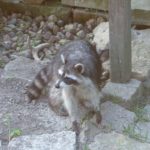
-
Raccoons forage mostly at night.
-

-
Pigeons depend on people to thrive.
by Winding Pathways | Jun 6, 2019 | (Sub)Urban Homesteading, Flowers/Grasses, Garden/Yard, Garden/Yard
Weeds Brighten Our Lawn
Too many people worry about lawn weeds and spend money to buy and spray toxic chemicals. We take a different view. What many call weeds are actually beneficial and we find fascinating. The often-uninvited plants that diversify our lawn connect us with human history, teach us botany, sometimes provide nutrition, and add color to our yard.
We don’t spray or fertilize our lawns at Winding Pathways. The mower gets exercise when grass gets shaggy, but we’re never bothered when new plants show up. Instead, we try to identify them and sometimes mow around them to let them bloom and add color to Winding Pathways.
Here are three “weeds” that we are enjoying this summer for their color:
Hawkweed

Hawkweed is “asexual”.
In mid-spring, a small patch of tiny hawkweed plants was poking through our grass. Rich mowed around them and by late May we enjoyed watching bright yellow hawkweed blooms dance in the sunny breeze.
There are many species of hawkweed. Most are exotic but some are native. Most sport yellow flowers although some can be reddish. Farmers sometimes consider them a weed. Perhaps the most interesting thing about them is their unusual reproduction. They usually spread by seed, but hawkweed seeds aren’t fertilized, meaning that the seed is an exact genetic clone of its parent. They’re asexual!
We’ll enjoy our Hawkweed until their blooms fade and then likely will mow the patch.
Star of Bethlehem
One of our favorite early spring wildflowers is the impressive but delicate bloom of the native Bloodroot. Its pure white petals are showy against the late March or early April ground. A common early summer lawn weed that has a bloodroot-looking flower is the Star of Bethlehem. It’s a lily that is sometimes sold in nurseries. The plant is not native and shows up in our lawn, probably the result of a previous owner planting bulbs years ago. Star of Bethlehem can be invasive, so we enjoy its showy bloom but mow it off before it has a chance to seed. The plant is a perennial and comes up from bulbs each year, so mowing won’t eliminate it but may keep it from seeding.
-

-
Bloodroot is an early spring bloomer. Photo credit Susan Hrobar
-

-
Star of Bethlehem.Six-petaled flower. Pixabay photo
Shepherd’s Purse

Shepherd’s Purse. From Pixabay
An intriguing plant that grows more on the side of the lawn than in the middle is Shepherd’s Purse. Its name comes from the triangular flat fruits that look like a tiny purse. Native to Europe and Asia Minor it may now be the second most common weed worldwide. Shepherd’s Purse has medicinal and food value and may have been deliberately spread by people.
Nature loves diversity. A function of invasive plants is their very nature. Spray a lawn and kill every plant species other than Kentucky Bluegrass and soon “weeds” will move right in. Diversity creates a certain degree of ecological stability, but there’s always change. A fascination of tending a natural unpoisoned lawn is learning to identify new species as they arrive by themselves and watching plant transitions over the years. A common uninvited plant one year may totally disappear the next to be replaced by some new species. Observing is just plain fun that can never be enjoyed by the person who poisons fascinating lawn plants.
by Winding Pathways | May 30, 2019 | (Sub)Urban Homesteading, Flowers/Grasses, Garden/Yard, Garden/Yard, Nature, Trees/Shrubs
Enjoying a Welcoming Yard
On the evening of May 17th, one of nature’s brightest colors greeted us at Winding Pathways. It was a brilliant male scarlet tanager, a somewhat rare bird that we only see briefly each May.
The next morning, he was joined by a female, and we assume they’ll nest in Faulkes Heritage Woods that adjoins our property. Tanagers are birds of the big woods, and they’ll find comfortable lodging in the big oaks nearby.
We bought Winding Pathways ten years ago partly because it adjoins the 110-acre Woods protected from development by a conservation easement. It’s mostly steep land that drops down to Indian Creek about a quarter of a mile from our home.
Creating a Welcoming Yard
Since we bought our land, we’ve diversified the yard by restoring prairies and increasing the variety of savanna and woodland wildflowers in shady areas, used prescribed fire to reduce exotics, and installed many birdhouses and feeders. Thanks to the nearby woods and our more open prairie yard with the savanna in between, we enjoy a rich array of bird species. Some, like woodpeckers and chickadees, stay around all year but more migrate to nest here or stop by on their trek to nest further north. We keep a running list of the birds we see from our dining room table each spring. Some we just see winging over but many stop to eat and rest.
-
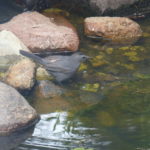
-
Catbird by water
-
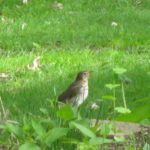
-
The Swainson’s Thrush moves through in the spring.
-
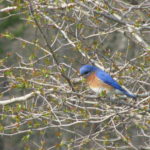
-
Bluebird in tree
Growing Bird List
We’re adding to this list daily but here’s what we’ve spotted and heard so far in May 2019:
Great Blue Heron, Barred and Horned Owl, Canada Goose, Black Capped Chickadee, Tufted Titmouse, Cardinal, White and Red Breasted Nuthatch, Downy, Hairy, Red Bellied, Red Headed, and Pileated Woodpeckers and Flicker, Turkey Vulture, House Sparrow, Wild Turkey, Red Breasted Grosbeak, Northern Oriole, Wood Duck, Common Yellowthroat, Indigo Bunting, Yellow Warbler, Louisiana Waterthrush, Blackpoll Warbler, Yellow Rumped Warbler, Scarlet Tanager, Eastern Kingbird, Phoebe, Great Crested Flycatcher, Cooper’s Hawk, Bald Eagle, Cowbird, House Sparrow, Starling, House and Carolina Wren, House Finch, Red Tail Hawk, Cooper’s Hawk, Crow, Pelican.
-
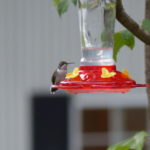
-
A hummer at the feeder.
-
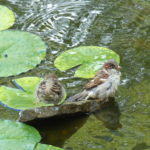
-
A water source helps attract birds.
-

-
Female Cardinal at window feeder.
And the list keeps growing. You, too, can create a welcoming yard. This introductory YouTube video from Canada gives a quick overview of the important elements in attracting birds to a yard. It’s totally “Homegrown” and short. You can create welcoming space on a condominium patio, at a retirement or nursing home, an urban lot or spacious acreage.
Another YouTube video explains how to bring natural elements together to create natural areas. In this case, a “forest.” Again, from large scale to small we can all do this! We would, naturally, adapt to our region of the country and world. The concepts are similar.
What to Consider When Creating a Welcoming Yard
How much time/money do you want to invest?
Do you want to create a naturalistic landscape with native plants?
Do you want to harvest food from the space?
Are your neighbors tolerant of change?
What local codes affect what you want to do? (Ordinances or Covenants)
How prevalent are deer in the neighborhood?
How long do you plan to live in the home?
-
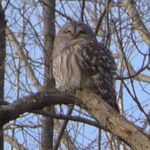
-
Waiting
-
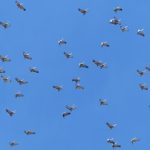
-
Wheeling overhead
-

-
A hooked rug by Yvonne Fellows
We’re lucky to have Indian Creek and Faulkes Heritage Woods near Winding Pathways, but even yards not adjacent to natural areas can increase bird variety by creating diverse habitat. Spring is the best season to plant prairies and shrubs! Learn more about birds, their habits and habitats at the Cornell Laboratory of Ornithology.
-

-
Extra nutrition at the feeder.
-

-
A male northern oriole
-
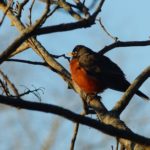
-
A robin surveys the area
by Winding Pathways | May 16, 2019 | (Sub)Urban Homesteading, Garden/Yard
For the past few years, Marion and I have conducted managed burns on our prairie and woodland areas in the fall. We let the fire rise from the woods up into the prairie near our home. This followed removing some maples a few years back to allow more light to reach the ground. I’ve attached a photo taken this week. In the foreground is the burned area. Behind is the unburned. The impact on wildflowers is amazing. The density and diversity of wildflowers in the burned area are much greater than in the unburned and they emerged sooner. In nearby Faulke’s woods, we removed maple understory several years ago but it has not burned. With the elimination of additional shading from maples, wildflowers are certainly increasing, but this area has not been burned so they are not nearly as prolific as in the burned area on our property. The dark, bare ground free of leaf cover warms more quickly and the woodland and prairie plants access the ash nutrients and receive the warmth of the sun. So, they grow more quickly and robustly.
-
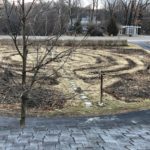
-
A fall labyrinth burn warms the soil for spring’s growth.
-
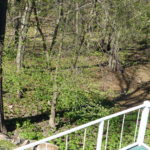
-
Leaf little slows plants emerging in the spring.
-
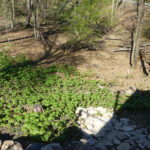
-
Note the difference between the burned area and unburned area.
by Marion Patterson | May 9, 2019 | (Sub)Urban Homesteading, Bugs, Foraging, Garden/Yard, Nature, Uncategorized
A delightful swatch of color flitted by as we sat on our back deck on one of spring’s first warm sunny days. It was a red admiral butterfly that landed on a post just a few feet from us. It appeared to be enjoying the weather as much as we were.
We’ve since spotted many red admirals in the yard, probably because stinging nettles thrive on the north end of our property. It’s the favored plant for red admiral caterpillars, although they’ll also live on other types of nettles. That poses somewhat of a dilemma.
What is a Red Admiral Butterfly?

These colorful butterflies depend on early blooming plants like nettles.
Red Admirals are a common butterfly across much of the temperate globe. They’re found across Europe and Asia, North Africa, Hawaii, and much of North America, especially the eastern half of our continent. The larvae feed on stinging nettles, which may not be native. So, if red admirals need stinging nettles what did they eat before the plant was introduced to North America in the early days of European exploration? It’s not even certain that stinging nettles are exotic. They may have been here all along, or early butterflies may have fed on wood nettles.
We appreciate both the insect and plant here at Winding Pathways. Red admirals add color and movement to the yard, while nettles make delicious eating. It’s the first wild green we harvest each early spring.
Can You Eat Nettles?

Carefully pluck the top three leaves off.
Stinging nettles are ready to harvest early – about the time when chard, spinach, and lettuce are planted. When the nettles are just a few inches tall we pluck off the top three or four leaves. They are called stinging nettles because the plant has tiny hairlike stingers. Walk through a patch in summer wearing shorts and nettles cause instant pain. But it’s temporary and not dangerous. Another name for the plant is the “seven-minute itch.” The sting comes from histamines.
We gather young nettles without getting stung by carefully plucking just the top leaves between our thumb and forefinger and snapping them off. About 100 young nettle tops make two servings. We bring them into the kitchen, rinse them a couple of times, and steam them for just a minute or two. The sting disappears and resulting greens are delicious. Plus they pack a nutritious array of vitamins and are high in protein.
Nettle season is short. By the time the plants are eight or ten inches tall, the new leaves are getting tough. But by then we’re harvesting chard and spinach from the garden.
We’re happy to share our yard with both red admirals and nettles. Anyone with a partly shady yard with damp soil might want to start a nettle patch. Wear a pair of gloves and dig up a few and plant them in the yard. They aren’t fussy and will provide excellent table fare and a higher likelihood that the yard will be home to the colorful butterfly.
by Marion Patterson | Apr 25, 2019 | (Sub)Urban Homesteading, Children/Play, Garden/Yard, Garden/Yard, Nature
-
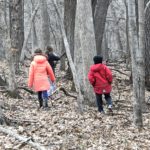
-
Kids take to the woods.
-
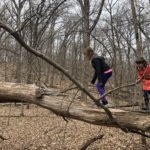
-
Starting off carefully.
-
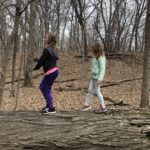
-
Walking confidently.
Kid Adventure
Nature reduces stress. We saw it in action at Winding Pathways on an early April Sunday morning.
About 15 kids from the Faith Formation Group of Peoples Church Unitarian Universalist visited. Most were five to ten years old. After collecting eggs and scattering treats for the hens, we took them to Faulke’s Heritage Woods. It’s a 110-acre woodland protected from development by a conservation easement held by the Iowa Natural Heritage Foundation.
It wasn’t a guided walk. It was a kid adventure. As we distantly watched, the kids scampered into the oaks where they discovered a huge fallen tree spanning a ravine. A natural bridge. They couldn’t resist making the crossing and then raced from fallen log to fallen log, traversing each. Laughter entertained the many standing trees as the kids were enveloped in nature, inventing games and having fun. No constructed playground in a city park or schoolyard matches the wonder and fun of ponds, prairies, and tiny streams.
-

-
Careful calculations
-

-
Learning to navigate a log.
-

-
Exploring the log
Lots of research has been conducted on nature’s ability to relieve stress in both adults and children. Experts call time spent in beautiful places the nature pill and even 20 minutes spent walking in the woods reduces stress.
Everyone Benefits
Mary Carol Hunter recently completed a nature pill study and said, “Our study shows that for the greatest payoff, in terms of efficiently lowering levels of the stress hormone cortisol, you should spend 20 to 30 minutes sitting or walking in a place that provides you with a sense of nature.”
We’re lucky to have Faulke’s Woods adjacent to Winding Pathways, but most of our time outdoors is spent close to our home on our own property. Often, it’s simply sitting in the yard enjoying a cup of coffee as we watch chickadees flit around.
Hunter’s words, “sense of nature” are powerful. Although visits to national and state parks, wildlife refuges, and nature preserves are wonderful stress relievers, anyone’s yard or balcony can do the same. We created Winding Pathways several years ago to encourage people to enjoy their yard, even if that’s a tiny apartment balcony in a big city. Structuring the yard or balcony to create natural beauty attracts interesting wildlife while giving people easy and free access to the “nature pill.”
Go outside and have fun, just like the kids did in Faulke’s Woods.






























